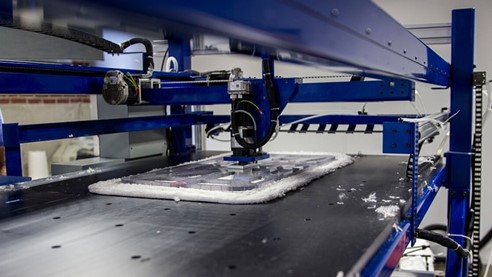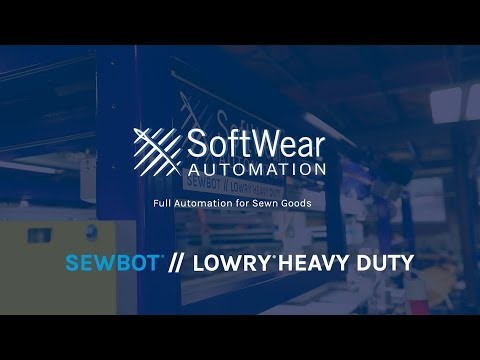Can not deny that the automation completely process unfortunately a large number of items so far are not yet available exam , but thanks to the improvements in certain endeavors in the production process also partly brought significant results for the industry.
Nitish Varshney 25/12/2020

A few years ago, robotic sewing was a controversial topic, the garment industry has not taken a clear direction as most people in the industry believe that robotic sewing is not feasible due to the different characteristics of the each fabric and this is true until now. It is undeniable that the complete automation of the sewing process of large numbers of items has not been feasible so far, but improvements in one stage of the production have also been somewhat effective. significant results for the industry.
All of these improvements are aimed at reducing the human intervention that is essential to the factory, gradually seeking to simplify complex human processes. In the past, a producer needed to calculate the costs (both direct and indirect) associated with performing complex processes when it was assigned hundreds of workers, but now it is possible to do the same process one by one. Automated pick and place systems are one of the innovations that promise to significantly reduce process costs and reduce human participation in complex processes.
Jack's 'Pick and Place Pick and Place' system applies robotic arm in sewing pattern ...

Jack Stock is headquartered in China, is a leading corporation in the world and also one of the pioneers with many innovations in sewing technology over the past decade. The automatic sewing system with the help of a robotic arm is predicted to gradually replace human labor on the sewing lines.
Thanks to attaching a robotic arm on the sewing machine axis, one operator can monitor 3 sewing machines at the same time. The invention of this robotic arm was developed by Jack Group in cooperation with Huawei, a leading Chinese electronics and technology supplier.
According to Martin - Regional Director (Middle East), a Jack shareholder, “The robotic arm equipped on our sewing system is the solution for those who are researching robot sewing applications in the industry sewing ”. The biggest advantage of this system is that it allows sewing two different designs using the same sewing machine. The sewing machine can visually identify the designs in the pattern and sew the corresponding pattern by attaching a camera mounted to the sewing head for identifying the sewing pattern. When receiving input from the sewing head, the robot arm selects the pattern from one sewing machine and places it on another sewing machine. All are automated, which saves the operator a lot of cost and time and can therefore increase the productivity of the entire process.
SoftWear Automation 's LOWRY robot created a revolution in the textile industry ...
US SoftWear Automation pioneers robotic automation in the textile industry thanks to LOWRY technology - using vision sensors, robots and cloud computing to automate fabric movement and sewing .
The LOWRY system is a 4-axis robot that can handle fabric, select and place operations, and direct sewing. The system uses a high-speed visual sensor to accurately monitor the fabric and prevent deformation during sewing.
This technology utilizes all advances in visual technology that help in the production of efficient garments. Visual technology can recognize sewing material shape, fabric size, style and sewing requirements to calculate and complete product automation. This helps to minimize repetitive operations, change or upgrade the look or appearance of the product, reducing costs and reducing time and labor. The display feature of the machine also helps the operator to see the fabric deformation in real time and automatically adjusts to correct the deformation without any external impact, helping to create a good high quality all the time.

According to SoftWear Automation, LOWRY can also perform automatic operations such as automatic spread, error detection, sewing, stitching, cutting, labeling and stacking all through a single touch panel. simplified. Up to six LOWRY can be controlled by just one operator at a time, greatly scaling up production.
Thanks to LOWRY technology, it is possible to create a large amount of cheap textile products such as home appliances, clothes, carpets and mats, etc.,
System upgrade / automatic unloading of Vibemac in machine sewing edging pocket helps simplify the entire process of production
At the largest garment technology exhibition in Asia CISMA (2019), Alberto Guerreschi, one of the major shareholders of the leading Italian sewing technology company Vibemac, commented: “Can we move to apply sewing? Robots, especially in the denim sector, where sewing a jeans complex is required? Is it really possible? "He correctly pointed out that inventing a complex robot can have limitations in performing complex garment operations. In its portfolio, however, Vibemac has automatic sewing machine parts that can deliver the same benefits at low cost, more workable, and, most importantly, safety. What Vibemac is doing is developing sewing machines with automatic lifting and unloading kits. In the future (including present),
This is exactly what Vibemac has been applying to the V700 / 701 bag lacing machine. In the upgraded version (V700LDR) of this pocket sewing machine, an automatic feed feeding system with 4 rotating spindles has been introduced. introduction. A dedicated loader can transfer bags to the conveying line via a robotic arm. When the bags are contoured, an idle unit automatically stacks the bags, in order, on the storage disc at the end of the transport. Vibemac calls this 'intelligent automation'.
Clips pick and place technology-based electrostatic of Grabit help produce exponential i NIKE shoes faster to produce a pair of Nike need 40 pieces of material, part vamp part is located on the top of the foot of the user, supplies Materials are stacked and heated to provide flexibility. It can take a worker up to 20 minutes to sort those materials, but if using a robot that picks up and places Grabit's Stackit, Nike can now produce its toe in as little as 50 seconds.
'Stackit' is an automated layered robot that delivers 20 times more productivity than before, with extremely high speed and accuracy of less than millimeters. In an 8-hour shift, Grabit's Stackit robot can produce 300-600 pairs of Nike boots. At this rate, Nike's return on investment (ROI) will maintain for 2 years.
Unlike many robots today, Grabit does not try to imitate human gripping techniques. Instead, it uses static electricity. The clamping machine uses a flat electrode pad that generates electric fields that adhere to most surfaces. This allows the holder to pick up the object and place it in a predetermined position. Its power gripper has the flexibility - easily stacking materials such as leather, mesh and composite fibers.
According to the report, each robot costs $ 100,000. Grabit customers are required to pay a software fee and must periodically replace their power pads. Nike is a trusted customer of Grabit technology. The company not only acquired Grabit's minority stake in 2013, but is also installing about a dozen Stackit robots across factories in Mexico and China.
https://vinatex.com.vn/cong-nghe-chon-va-dat-tu-dong-trong-san-xuat-hang-det-may-co-the-giup-tiet-kiem-chi-phi-truc-tiep/
Source: vinatex.com.vn